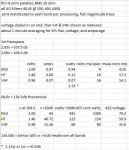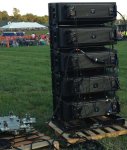Some finished shots...
Looks great Jason, how many did you end up building? Any tuning yet?
Some finished shots...
Are you planning on using them on their sides? Looks like you have feet on them for that? I've been curious as to how they would work in that orientation.Some finished shots...
Looks great Jason, how many did you end up building? Any tuning yet?
Are you planning on using them on their sides? Looks like you have feet on them for that? I've been curious as to how they would work in that orientation.

Here's a take at an overall sensitivity spec for the DIY 60...
Methodology was to put the usual ref voltage(s) 2v, 2.83v, on the mid section, and let the HF and VHF voltages fall where they may with a flat magnitude trace.
Attached spread sheet shows this, along with "rated continuous power" extrapolations....
Nothing new you can't find in previous posts, but does kinda show what a great balancing job Peter did...
Peter, hope the numbers make sense!
Hi Mark,
In my very first post I estimated the sensitivity for the Mid to be 105 dB/w/m and the HF & VHF to 112 dB. In theory, other than the low end extension, that should give a similar output to the old EAWKF850 in a much smaller and lighter box - http://eaw.com/docs/2_Legacy_Products/Loudspeakers/KF/KF850/KF850e/KF850EF_polar.pdf
Its great to see it supported by some measurements ...
Peter

So here's my question, can I build this box and just use a miniDSP and setting suggestions from board members to make it sing?
I hadn't logged on in awhile.
@ Max and Mark: thanks for the explanations. It was actually a confidence booster. I am a bit concerned about DSP. My thoughts were 1 miniDSP board per cab for the 3-way. The balanced kit seemed like the way to go. I guess I haven't looked into it deep enough. Can you explain what the specific limitations are and how I can correct them?
On another note I also though about using a DCX. I know they aren't the greatest and could use some improvements to components. I've heard of the opamp upgrades people do on these.
Probably this one:Which balanced kit are you talking about?
Actually it was this one.
https://www.minidsp.com/products/minidspkits/2-x-in-4-x-out-bal
